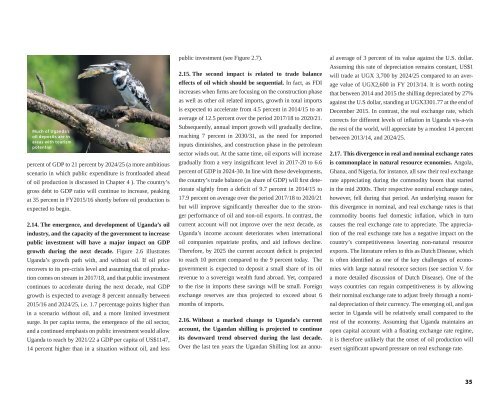Economic Diversification and Growth
71mK301zeG0
71mK301zeG0
Create successful ePaper yourself
Turn your PDF publications into a flip-book with our unique Google optimized e-Paper software.
Much of Ug<strong>and</strong>a’s<br />
oil deposits are in<br />
areas with tourism<br />
potential<br />
percent of GDP to 21 percent by 2024/25 (a more ambitious<br />
scenario in which public expenditure is frontloaded ahead<br />
of oil production is discussed in Chapter 4 ). The country’s<br />
gross debt to GDP ratio will continue to increase, peaking<br />
at 35 percent in FY2015/16 shortly before oil production is<br />
expected to begin.<br />
2.14. The emergence, <strong>and</strong> development of Ug<strong>and</strong>a’s oil<br />
industry, <strong>and</strong> the capacity of the government to increase<br />
public investment will have a major impact on GDP<br />
growth during the next decade. Figure 2.6 illustrates<br />
Ug<strong>and</strong>a’s growth path with, <strong>and</strong> without oil. If oil price<br />
recovers to its pre-crisis level <strong>and</strong> assuming that oil production<br />
comes on stream in 2017/18, <strong>and</strong> that public investment<br />
continues to accelerate during the next decade, real GDP<br />
growth is expected to average 8 percent annually between<br />
2015/16 <strong>and</strong> 2024/25, i.e. 1.7 percentage points higher than<br />
in a scenario without oil, <strong>and</strong> a more limited investment<br />
surge. In per capita terms, the emergence of the oil sector,<br />
<strong>and</strong> a continued emphasis on public investment would allow<br />
Ug<strong>and</strong>a to reach by 2021/22 a GDP per capita of US$1147,<br />
14 percent higher than in a situation without oil, <strong>and</strong> less<br />
public investment (see Figure 2.7).<br />
2.15. The second impact is related to trade balance<br />
effects of oil which should be sequential. In fact, as FDI<br />
increases when firms are focusing on the construction phase<br />
as well as other oil related imports, growth in total imports<br />
is expected to accelerate from 4.5 percent in 2014/15 to an<br />
average of 12.5 percent over the period 2017/18 to 2020/21.<br />
Subsequently, annual import growth will gradually decline,<br />
reaching 7 percent in 2030/31, as the need for imported<br />
inputs diminishes, <strong>and</strong> construction phase in the petroleum<br />
sector winds out. At the same time, oil exports will increase<br />
gradually from a very insignificant level in 2017-20 to 6.6<br />
percent of GDP in 2024-30. In line with these developments,<br />
the country’s trade balance (as share of GDP) will first deteriorate<br />
slightly from a deficit of 9.7 percent in 2014/15 to<br />
17.9 percent on average over the period 2017/18 to 2020/21<br />
but will improve significantly thereafter due to the stronger<br />
performance of oil <strong>and</strong> non-oil exports. In contrast, the<br />
current account will not improve over the next decade, as<br />
Ug<strong>and</strong>a’s income account deteriorates when international<br />
oil companies repatriate profits, <strong>and</strong> aid inflows decline.<br />
Therefore, by 2025 the current account deficit is projected<br />
to reach 10 percent compared to the 9 percent today. The<br />
government is expected to deposit a small share of its oil<br />
revenue to a sovereign wealth fund abroad. Yet, compared<br />
to the rise in imports these savings will be small. Foreign<br />
exchange reserves are thus projected to exceed about 6<br />
months of imports.<br />
2.16. Without a marked change to Ug<strong>and</strong>a’s current<br />
account, the Ug<strong>and</strong>an shilling is projected to continue<br />
its downward trend observed during the last decade.<br />
Over the last ten years the Ug<strong>and</strong>an Shilling lost an annual<br />
average of 3 percent of its value against the U.S. dollar.<br />
Assuming this rate of depreciation remains constant, US$1<br />
will trade at UGX 3,700 by 2024/25 compared to an average<br />
value of UGX2,600 in FY 2013/14. It is worth noting<br />
that between 2014 <strong>and</strong> 2015 the shilling depreciated by 27%<br />
against the U.S dollar, st<strong>and</strong>ing at UGX3301.77 at the end of<br />
December 2015. In contrast, the real exchange rate, which<br />
corrects for different levels of inflation in Ug<strong>and</strong>a vis-a-vis<br />
the rest of the world, will appreciate by a modest 14 percent<br />
between 2013/14, <strong>and</strong> 2024/25.<br />
2.17. This divergence in real <strong>and</strong> nominal exchange rates<br />
is commonplace in natural resource economies. Angola,<br />
Ghana, <strong>and</strong> Nigeria, for instance, all saw their real exchange<br />
rate appreciating during the commodity boom that started<br />
in the mid 2000s. Their respective nominal exchange rates,<br />
however, fell during that period. An underlying reason for<br />
this divergence in nominal, <strong>and</strong> real exchange rates is that<br />
commodity booms fuel domestic inflation, which in turn<br />
causes the real exchange rate to appreciate. The appreciation<br />
of the real exchange rate has a negative impact on the<br />
country’s competitiveness lowering non-natural resource<br />
exports. The literature refers to this as Dutch Disease, which<br />
is often identified as one of the key challenges of economies<br />
with large natural resource sectors (see section V. for<br />
a more detailed discussion of Dutch Disease). One of the<br />
ways countries can regain competitiveness is by allowing<br />
their nominal exchange rate to adjust freely through a nominal<br />
depreciation of their currency. The emerging oil, <strong>and</strong> gas<br />
sector in Ug<strong>and</strong>a will be relatively small compared to the<br />
rest of the economy. Assuming that Ug<strong>and</strong>a maintains an<br />
open capital account with a floating exchange rate regime,<br />
it is therefore unlikely that the onset of oil production will<br />
exert significant upward pressure on real exchange rate.<br />
35


